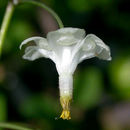ar
الأسماء في صفحات التنقل


Vancouveria hexandra, or the Inside-out flower, is a perennial herb in the Berberidaceae, or barberry family. It is native to northern California originally, but has now become common in the Pacific Northwest to the west of the Cascade Mountains from Washington, through Oregon, to northern California (Alden 1998; Knoke and Giblin 2017).
The characteristic of this plant that gives it its name is that the stem attaches inside the flower, with the 4-6 mm petals and 5-12 mm sepals flaring backwards, pushing out the six stamens, pistil, and ovary and making them quite visible (Flora of North America 2017; Pojar and Mackinnon 2004). The Inside-out flower has a maximum height of 30 cm and its leaves, which are all basal, range from 10-20 cm. The flowers themselves, of which there are usually 10-30 per plant, have a shooting star shape with six petals and six sepals. The crescent shaped seeds are black and are covered and protected by green to light brown follicles. The light-green to dark- green leaves are twice divided into 3’s and usually have 9-15 leaflets. The leaflets are webbed with typically 3 points (Flora of North America 2017).
The Inside-out flower can sprawl widely, but is not usually overpowering for other plant species. Reproduction depends upon insects, some of which, especially wasps and ants, will sometimes disperse the seeds across the forest floor (Washington Native Plant Society 2017). V. hexandra fares best in the soil with plentiful shade in low to moderate elevations, where it blooms from May to July (Flora of North America 2017).
Vancouveria hexandra, the white inside-out flower, is a perennial herb in the barberry family Berberidaceae. It is found in southwestern British Columbia, western Washington and Oregon and northwestern California and is a common understory herb in moist, shady Douglas fir forests.[1][2]
This plant grows 20–40 centimetres (8–16 in) high with compound leaves in triplets and is usually found in dense patches. It gets its name from the small delicate white flowers with petal-like sepals that are swept back abruptly as if in the process of turning inside out. The genus honors George Vancouver, the 18th-century explorer of the Pacific Northwest.[3][4][5]
Vancouveria hexandra, the white inside-out flower, is a perennial herb in the barberry family Berberidaceae. It is found in southwestern British Columbia, western Washington and Oregon and northwestern California and is a common understory herb in moist, shady Douglas fir forests.
This plant grows 20–40 centimetres (8–16 in) high with compound leaves in triplets and is usually found in dense patches. It gets its name from the small delicate white flowers with petal-like sepals that are swept back abruptly as if in the process of turning inside out. The genus honors George Vancouver, the 18th-century explorer of the Pacific Northwest.